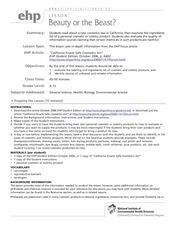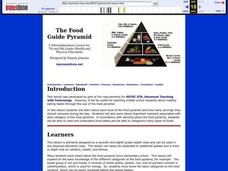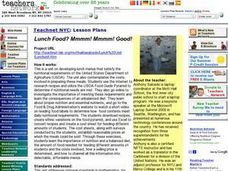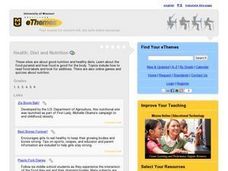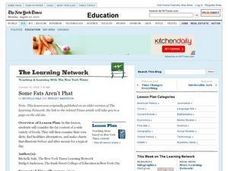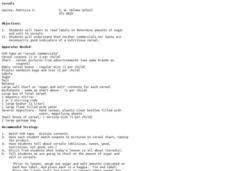Curated OER
Food Labels in the Classroom
Students study the nutritional information on food labels and become familiar with the basic dietary needs of the human body. They write letters to food companies.
Curated OER
Food Labels
Young scholars discover more about nutrients in the food they eat by reading food labels. This lesson will also allow students to demonstrate skills on word processor by designing a menu.
Curated OER
Food Labels Lesson
Young scholars analyze nutrition by completing an interactive activity with classmates. In this food choice activity, students discuss the importance foods have on our daily lives by keeping us healthy and giving us energy. Young...
Curated OER
Nutrition Labels
Students read and interpret nutrition fact labels ("food labels") from food products, a task that involves the use of various mathematics skills (e.g., number concepts and number sense).
Curated OER
Beauty or the Beast
Does the FDA really intend to protect public health? Spark a debate in your chemistry or health class by using this article, titled "Beauty or the Beast." It questions the safety of cosmetics and toiletry products, govenment regulations,...
Curated OER
Lesson 3: Nutrition, Labeling and Packaging
Students explore basic nutrition concepts to help them select healthy diet, evaluate food intake, discuss major food labeling issues, design labels for food products, examine history of food packaging development and how packaging...
Curated OER
The Food Guide Pyramid
Students examine each level of the food pyramid and how many servings they should consume during the day. They study the important nutrients associated with each category of the food pyramid.
Curated OER
Lunch Food? Mmmm! Mmmm! Good!
Examine how nutrition plays an important role in our lives by conducting online research and developing lunch menus that satisfy nutritional requirements set up by the United States Department of Agriculture. Students download recipes,...
Curated OER
Rice Nutrition
Third graders investigate nutrition by researching rice. In this food instructional activity, 3rd graders read about the healthy aspects of rice and how many people in the world eat it. Students read nutrition labels and...
Curated OER
Food Labels in the Classroom
Learners read all information given on packaging; write down complete ingredients and grams of protein, carbohydrates and fat per serving. They compare the information with current health references and write a business letter to a food...
Curated OER
Sugar-Coating the Facts
Students explore the food industry's influence on American Student nutritional habits and analyze the nutrition charts found on food packaging. They design their own warning labels for foods targeted at Students.
Curated OER
A Healthy Diet
Students examine their own fast food habits and discuss the poor nutritional value of this type of food. They read nutritional labels on popular packaged foods. They analyze the risks of a diet high in fat and sodium versus a well...
Curated OER
Health: Diet and Nutrition
Students access a variety of nutrition and health related resources on the Internet. They examine the food pyramid, match food groups, play interactive games, read an online story, analyze the labels on food packaging, and take a...
Curated OER
Breads And Nutritional Labels
Seventh graders investigate the concept of a nutritional label used on bread products. They read different labels in order to strengthen reading skills and interpreting nutritional information. The information is used in order to create...
Curated OER
When Something's Missing: Diagnosing Vitamin Deficiencies
The New York Times "Education" section posts an extensive activity on vitamin and mineral deficiencies. It involves class discussion, examination of food packaging labels, and the reading of a blog post about Vitamin D. The highlight of...
Curated OER
Understanding Food Labels
Students determine the number of calories, serving size, and vitamins and minerals in different food products and use this information to create a formula determining the number of calories per serving size and the daily percentages of...
Curated OER
Where Do I Fit In The Food Pyramid?
Students discuss how their daily diets fit into the dietary guidelines set out by the food pyramid. They write a paragraph describing good health habits and identify areas where their personal diet can be improved.
Curated OER
Some Fats Aren't Phat
Young scholars examine nutritional information on various food labels and then consider the nutritional value of the foods in their own diets. They create posters illustrating their diets "before" and "after" they considered their fat...
Curated OER
Food Pyramid
First graders examine the different levels of the food pyramid and plan a healthy meal. They discuss the food pyramid and read about nutrition using a variety of resources. Using Kidspiration computer software, they plan a...
Curated OER
Mmmmm, I'm Good! But Am I Good For You?
Learners explore the nutritional value of the potato, its role in the food pyramid, and how it can be a part of a balanced diet. For this potato nutrition lesson, students read about the nutritional value of potatoes. Learners work in...
Curated OER
The Secreat to Good Health: Eating Right and Exercise
Young scholars create a seven-day record of all the foods they consume. They analyze what type of food was the most frequent in everyone's diet. They look up each food and record its daily recommended amount.
Curated OER
Nutrition Unit
First graders complete activities for the six basic food groups. In this food groups lesson plan, 1st graders view examples of food samples from the various groups and sample the foods. Students discuss the food pyramid and draw a fruit...
Curated OER
A Feast for the Future
Students participate in an activity that uses a simulated meal of transgenic foods in order to initiate a discussion of the controversy concerning the use of transgenic food products.
Curated OER
Cereals
Young scholars watch television commercials, then analyze the nutritional value of the cereals. In this health and nutrition instructional activity, the teacher shows students several cereal commercials, then the young scholars describe...




